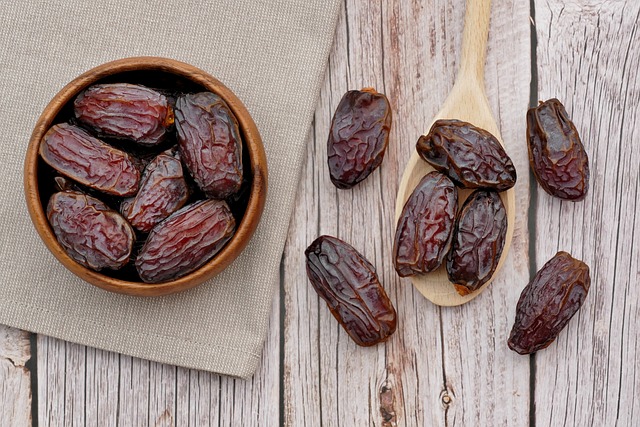Dates and prunes are dried fruits, but from different trees. Dates come from date palms and are sweet, while prunes come from plums and are known for aiding digestion.
TL;DR Dates Vs. Prunes
Dates are sweet and sticky fruits that come from the date palm tree. They are rich in fiber, potassium, and various vitamins. Dates can be consumed fresh or dried, making them a versatile ingredient in many recipes.
Prunes are dried plums known for their wrinkled appearance. They are packed with nutrients like fiber, antioxidants, and vitamin K. Prunes are often revered for their digestive benefits.
What are dates?

Dates are the fruit of the date palm tree (scientifically known as Phoenix dactylifera). They are a type of sweet and nutritious dried fruit that has been cultivated for thousands of years in various parts of the world, particularly in Middle Eastern and North African countries.
Dates are oval-shaped and typically have a wrinkled, brownish exterior. They are known for their natural sweetness and are often consumed as a snack or used in various culinary preparations, such as desserts, smoothies, and energy bars.
Dates are rich in dietary fiber, vitamins, minerals, and antioxidants, making them a popular choice for both their flavor and nutritional value.
What are prunes?

Prunes are a type of dried fruit that is known for its distinctive sweet and tangy flavor. They are made from drying plums, specifically the European variety called Prunus domestica.
The drying process removes most of the water content from the plums, resulting in a shriveled appearance and concentrated taste.
One key characteristic of prunes is their high fiber content. This makes them an excellent natural remedy for constipation and helps to promote healthy digestion. Additionally, prunes are packed with essential vitamins and minerals such as potassium, vitamin K, and antioxidants.
Dates Vs. Prunes – Key differences
| Aspect | Dates | Prunes |
|---|---|---|
| Origin | Derived from date palm trees | Derived from various types of plum trees |
| Appearance | Typically oblong with wrinkled skin | Usually round with wrinkled skin |
| Color | Brownish-black or reddish-brown | Dark purple or black |
| Taste | Sweet and rich | Sweet with a slightly tart undertone |
| Texture | Soft and chewy | Soft and somewhat sticky |
| Nutritional Value | Good source of dietary fiber, vitamins, minerals | Good source of dietary fiber, vitamins, minerals |
| Fiber Content | High fiber content | High fiber content |
| Natural Sugars | High in natural sugars | High in natural sugars |
| Common Uses | Snacking, baking, desserts, smoothies | Snacking, baking, cooking, salads |
| Health Benefits | Digestive health, energy boost, nutrients | Digestive health, bone health, antioxidants |
| Calories | Moderately high in calories | Moderately high in calories |
| Serving Size | Typically consumed in small amounts | Typically consumed in small amounts |
| Culinary Uses | Stuffed, used in energy bars, date paste | Used in cooking, baking, compotes |
| Drying Process | Naturally dried or commercially dried | Dried through sun exposure or processing |
Types of dates
Medjool: Known as the “king of dates,” Medjool dates are large, soft, and sweet. They have a caramel-like flavor and are often enjoyed as a natural sweetener or in desserts.
- Ajwa: Ajwa dates are a special variety from Al-Madinah in Saudi Arabia, known for their significance in Islamic traditions and potential health benefits.
- Deglet Noor: These dates are semi-dry and have a slightly chewy texture. They are often referred to as “the date of light” due to their translucent appearance. Deglet Noor dates are less sweet compared to Medjool dates.
- Barhi: Barhi dates are small, round, and golden-yellow when ripe. They have a creamy texture and are often consumed when still in their crunchy, early stage or when fully ripe and soft.
- Halawy: Halawy dates are medium-sized with a soft and smooth texture. They have a caramel-like taste and are known for their melt-in-your-mouth quality.
- Dayri: Dayri dates are medium-sized and dark in color. They have a firm texture and a rich, nutty flavor. They’re often used for snacking.
- Khudri: Khudri dates are small to medium-sized and have a wrinkled appearance. They are less sweet and have a slight nuttiness to their flavor.
- Thoory: Thoory dates are oblong and have a drier, less juicy texture. They are commonly used for cooking and are sometimes referred to as “bread dates.”
- Zahidi: Zahidi dates are medium-sized and pale yellow to light brown. They have a firm texture and a slightly sweet, nutty taste.
- Empress: Empress dates are large and oval-shaped, with a chewy texture and a rich, sweet flavor. They are often used in baking and desserts.
Image Credits
Featured Image By – Pictavio from Pixabay
Image 1 By – azerbaijan_stockers on Freepik
Image 2 By – Emőke Dénes, CC BY-SA 4.0 , via Wikimedia Commons








